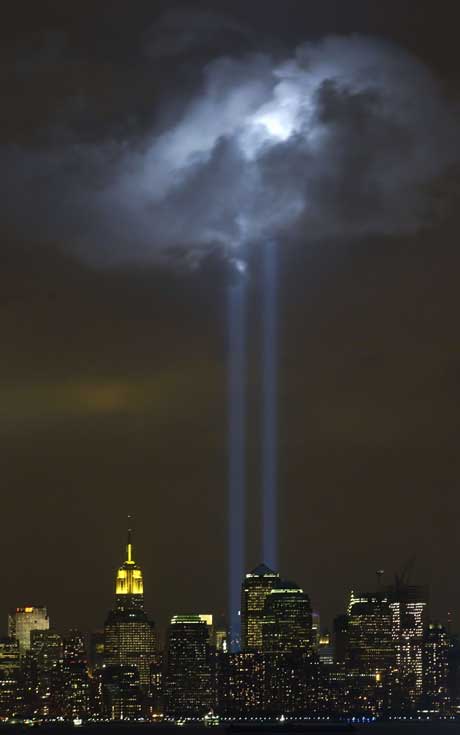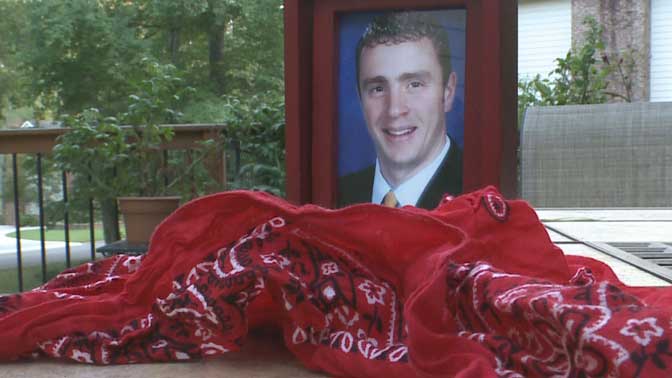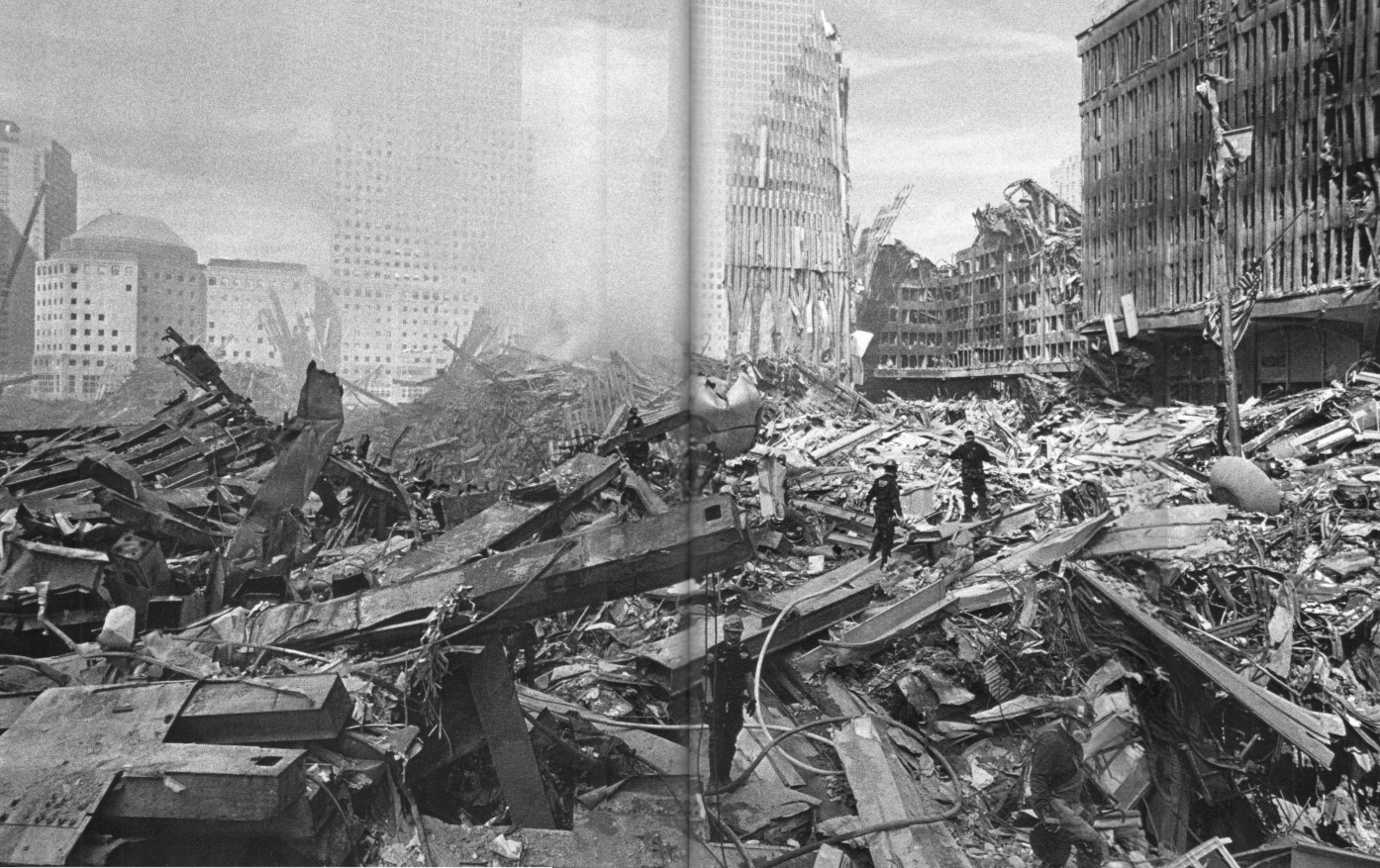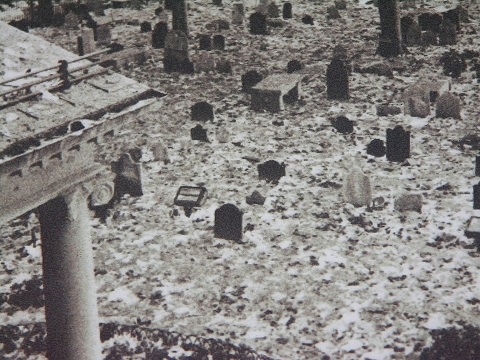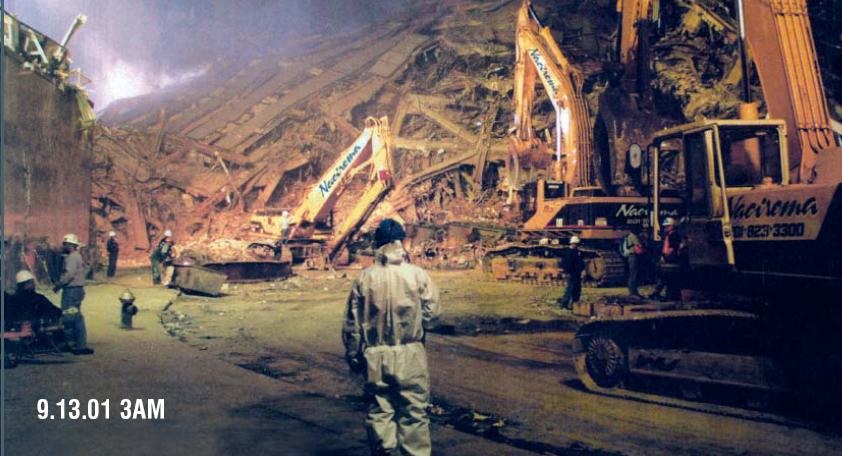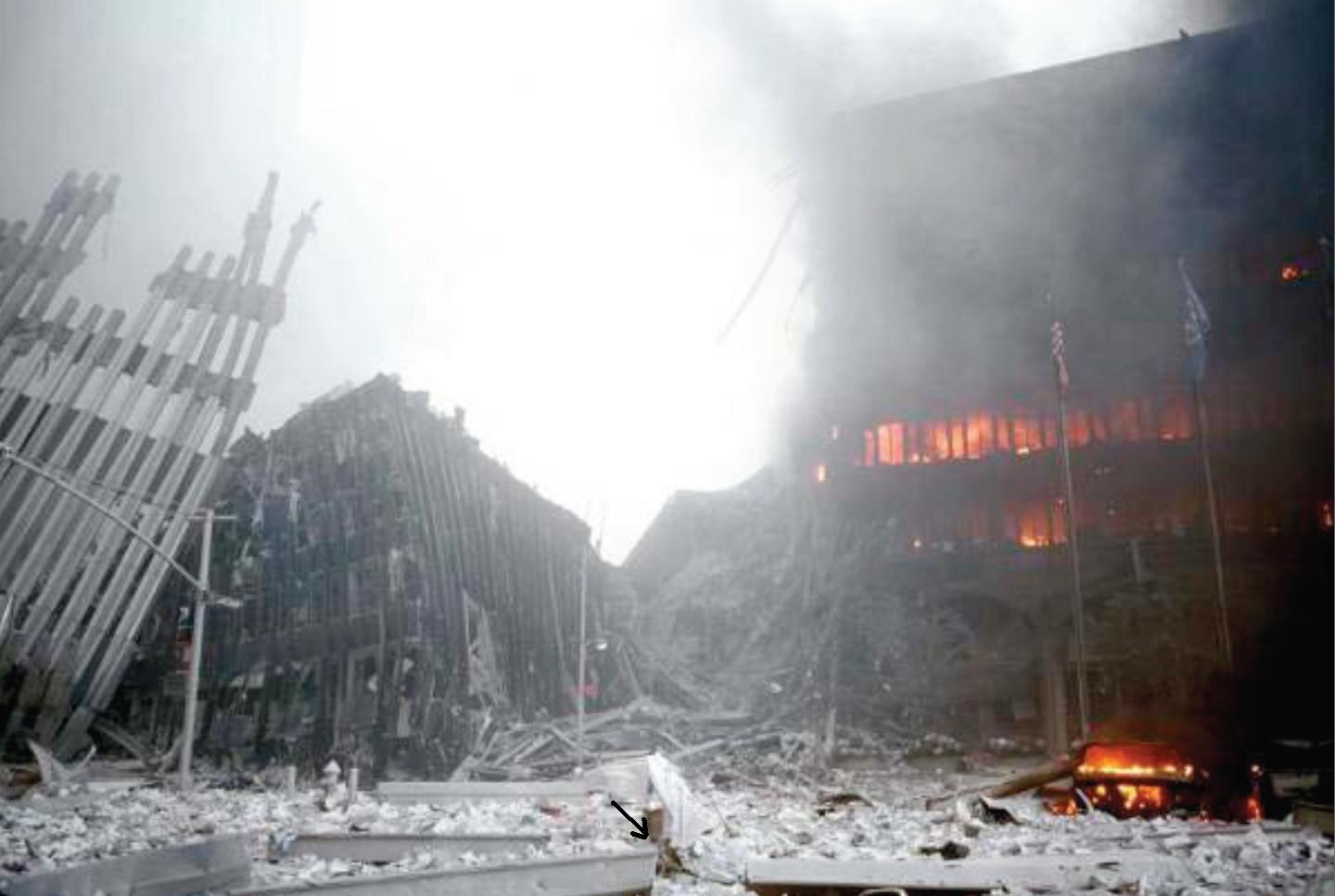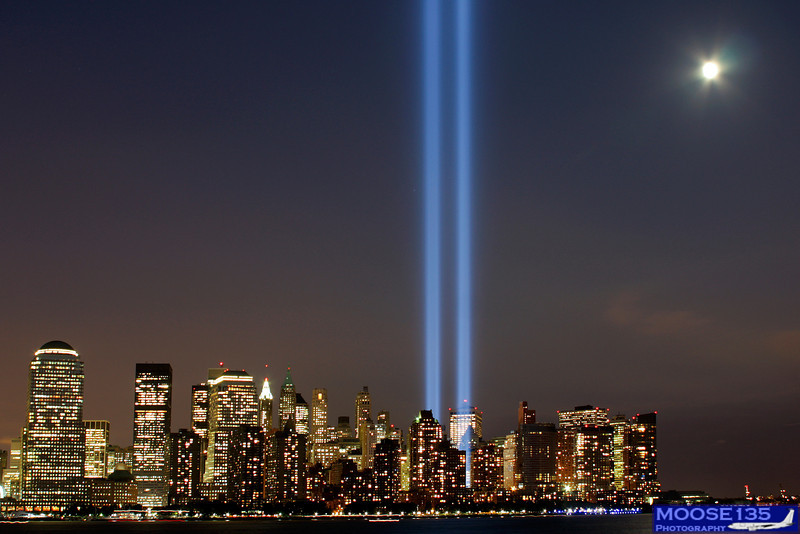‘We Will Not Leave Its Lesson’
Enduring Truths from 9/11 in Three Parts
I
‘It’s All About Teamwork’
A blind man, his guide dog and their mutual survival on 9/11
By Duncan Strauss
Host, Talking Animals, at NPR affiliate station WMNF-FM, Tampa, Florida; online at www.talkinganimals.netIt’s safe to say that many of us might not be overly keen to read the expression “The blind leading the blind.” Let’s face it: It’s a cliché, a hackneyed phrase that may bespeak intellectual fuzziness, or just plain ol’ laziness, on the part of the writer.
It may be equally safe to say that phrase becomes something altogether more compelling, poignant and profound when it’s written by Michael Hingson, blind since birth, to describe how he and his guide dog, Roselle, took the arm of an elderly woman walking into the Fulton Street Subway Station, not far from the World Trade Center on 9/11; she was unable to see in the swirl of dust, smoke and debris produced moments earlier by the horrid attack on the Twin Towers.
“The woman responds, clutching my arm,” Hingson recounts in his book, Thunder Dog: The True Story of A Blind Man, His Guide Dog & the Triumph of Trust at Ground Zero.
“This time the blind really is leading the blind, but why should that be unusual? After all, helping this lady is what teamwork is all about.”
And Hingson is nothing if not deeply steeped in teamwork. From his childhood in Palmdale, CA, when he was paired with his first guide dog, to his lifelong career in high-tech sales and sales management, to how he made his way from the North Tower after the plane hit that morning, later helping that woman in the subway station…teamwork is the through-line of his colorful, often-galvanizing saga.
Michael Hingson, with his new guide dog, africa, and his co-author Susy Flory talk about his book Thunder Dog: ‘This is a book about the human-animal bond, and the trust and faith that we have that helped me to live another day after terrorists attacked my building, the World Trade Center.’Indeed, in interviewing Hingson on Talking Animals on the eve of the 9/11 10th anniversary, he observed, “Thunder Dog is all about teamwork. It’s all about trust, it’s all about people working together, people and dogs working together to do something that needed to be done, to do something great—to get a bunch of people out of the World Trade Center.”
Thunder Dog may be one of those books that’s about different things for different readers—and may be about something yet again different for the author. Unequivocally, it’s a spirited yarn told by Hingson about working in the North Tower on 9/11, and being led to safety from the 78th floor by Roselle, interwoven with a memoir of sorts, chronicling his life before and after that day.
Improbable as it might sound, there are times when the memoir part is no less striking than the blind-guy-makes-it-out-safely-from-the-78th-floor-of-the-Towers part.
As one measure of this, heck, look no further than the topic of locomotion: Hingson rode a bike when he was a little kid, drove a car when he was a college student, and flew a plane when he was a young adult. (I can’t remember—did I mention he’s blind?)
Hingson also laces the book with information and statistics—for instance, the employment rate of employable blind people hovers near 70%--that paints a surprisingly bleak picture of the advances blind people have made toward inclusiveness, socially and professionally, and toward fostering a more enlightened view of the unsighted by the sighted. “The truth is, I face discrimination every day,” Hingson writes in Thunder Dog.
This statement feels even more jarring because by that point in the book we already know he’s a University of California (Irvine) cum laude graduate who went on to earn a master’s degree in physics. And that he’s a hotshot sales executive selected by his bosses at Quantum Corporation, a Fortune 500 company, to open its new office in 2000 at the World Trade Center.
Still, one of the unfortunate motifs of the book is that even someone like Hingson, who’s enormously accomplished, confident and successful at every phase of his life, isn’t inoculated against what might otherwise feel like an antiquated prejudice against the blind.
“Blindness isn’t the handicap I face,” Hingson announced early in the Talking Animals interview, a feisty edge to his voice. “The handicaps are the attitudes and misconceptions that people have about blindness, and their presumption that because you can’t see, you can’t do stuff. And that things they believe can only be done by people with eyesight are not, in fact, only done by people who have eyesight—blind people do them, too.
A singular example of that might constitute his riveting tale, told in Thunder Dog in episodic fashion, about making that journey down 78 flights of stairs on 9/11, with Roselle’s assistance, not only exiting safely from Tower One but helping others from the building to do so.
“Roselle and I worked as a team,” he recalled on the show, reconstructing that harrowing day. “I focused on keeping her calm and telling her that we were OK, and that I wasn’t nervous. And, in turn, her guiding was flawless, which told me that she wasn’t detecting anything that made her nervous. So the two of us worked together.”
In a word, teamwork.
Michael Hingson and Roselle on Larry King Live, September 11, 2002But en route to descending that stairwell with his colleague, David Frank, and Roselle (who, afflicted with kidney disease, retired from guide work in 2007 and died this past June at age 13), Hingson remembers in the book how he still managed to face a bout of that anti-blindness bias.
A well-meaning firefighter was adamant about sending a colleague to assist Hingson in navigating down the stairwell. Hingson, understanding the well-intentioned gesture, nonetheless felt equally adamant that he did not need help. The firefighter was clearly becoming peeved that Hingson was resisting his entreaties, but if you think Hingson was going to have unwanted help forced on him—even (or especially) in the midst of this cataclysmic morning—you may have dozed off a few paragraphs earlier.
In the Talking Animals conversation, he elaborated on that episode, and why he politely declined the help, in a way that encapsulated much of the Hingson ethos. “I resisted that mainly because I didn’t need any help getting down the stairs,” he said. “And I didn’t want to take a fireman out of their position in line and doing the work they were doing, to get me down the stairs, and then find out later that someone had been injured or killed because the fireman wasn’t where he was supposed to be.
“And the fact is that I’m just as capable as going down the stairs as you. So we worked at it, and finally I had to use the last card available, which was ‘I was already with a friend who could see, don’t worry about us’. …The fireman petted Roselle, she gave him kisses, and he was petting her—and, of course, it wasn’t the time to give him a lecture about not petting a guide dog in harness.
“But, you know, they went upstairs and did what they needed to do. And, probably, those kisses from Roselle was the last unconditional love he ever got in his life.”
Thunder Dog: The True Story of a Blind Man, His Guide Dog, and the Triumph of Trust at Ground Zero is available at www.amazon.com
Duncan Strauss’s complete Talking Animals interview with Michael Hingson is available online at www.talkinganimals.net
***
II
The Man In the Red Bandanna
The story of Welles Crowther, a former Boston College lacrosse player who worked as an equities trader at Sandler O’Neill and Partners on the 104th floor of the South Tower of the World Trade Center. On September 11, 2001, after the tower was struck, Crowther, who was going to leave his job to become a New York City firefighter, escorted 12 people to safety before the tower collapsed as he was on his way back up the stairs to help more victims escape. Narrated by Ed Burns, the following profile of Crowther was first aired on ESPN’s Outside the Lines.
***
Ground Zero: An Exercise In Humanity
'Spirit,' Scrooge said, 'this is a fearful place. In leaving it, I shall not leave its lesson, trust me. Let us go!'--from Charles Dickens' "A Christmas Carol"
By David McGee
[Note: In January 2002 the following piece was written expressly for a corporate newsletter published by my then-employer, United Entertainment Media. It was not distributed outside the company nor has it been published elsewhere, save for the September 2010 issue of TheBluegrassSpecial.com. These reflections on my months as a volunteer at Ground Zero are unaltered from what I had observed up to the time of this writing. On the 10th anniversary of the 9/11 attacks, and in conjunction with Duncan Strauss’s interview with Michael Hingson and ESPN’s moving segment on the 9/11 heroics of Welles Crowther, it seemed proper to round out our coverage with this first-person account as another perspective on what it was really like in the belly of the beast, and why we are still a long way from the moment when, as Mark Twain observed, “tragedy plus time equals comedy.” Some things simply cannot be overemphasized.]
There are no metaphors for Ground Zero.
Each night I spend volunteering at the site of the attack on the World Trade Center, there comes a moment when I survey the utter devastation around me and think, There are no metaphors for this. It can't be likened to anything else. The New York Times runs a story speculating on how artists will respond to the events of September 11 and beyond, and I think, What a fruitless endeavor, in light of the cold, hard facts.
When I started my volunteer work, on the third day following the attack, there were estimated to be around 6,000 dead; that number has since been revised downward, to "only" 3,000 or so. In addition to the 110-story towers, all the buildings in the WTC plaza are gone--WTC 7 collapsed on 9/11, shortly after the twin towers fell; WTC 4 and 5 are burned out, creaking hulks, partially collapsed, and about to be dismembered; the Marriott Hotel is smoldering rubble slated for the wrecking ball; the Bankers Trust building--not even in the plaza but across the street from it--has a charred gash in its façade about midway down, running the length of seven stories, the aftermath of a white-hot beam of steel cutting through it after being blown off one of the towers' facades and launched like a missile southward. To the east of the plaza sits the Millennium Plaza Hotel, shrouded in orange netting that in theory serves the purpose of allowing nearby workers a few extra seconds to bolt out of the area when the building collapses. Next to the Millennium Plaza is the Century 21 building, also shrouded in orange netting; and next to it, the office building, 1 Liberty Plaza, which three engineers have told me is going to go, although it has been cleaned and workers have returned to their jobs inside, much to the astonishment of everyone else who has been at Ground Zero for any length of time and has had to sprint away from 1 Liberty on the occasions when three horn blasts have signaled an expected collapse. So far, it stands.
Apart from the debris from the collapsing towers that covered the graveyard in soot and paperwork several inches deep, St. Paul's suffered nary a crack or ding in the collapse, when all around it supposedly sturdier structures were being wiped out.Directly behind the WTC plaza is St. Paul's Chapel, built in 1775. Its cemetery is one of the oldest in Manhattan, its stained glass windows among the most beautiful. Apart from the debris from the collapsing towers that covered the graveyard in soot and paperwork several inches deep, St. Paul's suffered nary a crack or ding in the collapse, when all around it supposedly sturdier structures were being wiped out. "That place is as solid as the day it was built," an engineer told me following a thorough inspection. It was as if God placed a protective hand over the building and said, "Uh-uh, you aren't getting this one."
It was to St. Paul's that I came on 9/14, following a prayer service at the Cathedral of St. John the Divine, on 110th Street and Amsterdam Avenue, more or less my neighborhood on the upper west side of Manhattan. Like thousands of New Yorkers, I wanted to do something to help my city; unlike thousands of New Yorkers, I happened to be in the right place at the right time to lend a helping hand, even as word was going out over every media outlet that no more volunteers were needed downtown. A gentleman affiliated with St. John's was complaining loudly after the service that he could not find anyone to work the night shift. When I approached and asked what he needed, he queried in return as to whether I could cook ("Well, certain things," I said, choosing not to reveal my limited repertoire then and there) and whether I could stay up all night (being in and around the music business for some 27 years, and being nocturnal by nature, that was most certainly not a problem). He then revealed that his organization--a seminary that was in turn connected to the Seamen's Institute on Water Street, about a quarter mile east of the WTC--was engaged in an around-the-clock mission of providing hot food for the rescue workers.
Sign me up.
"Let me ask first: do you have any respiratory problems?"
No.
"Good. Because the air is pretty vile down there."
"Down there" turned out to be another world. National Guard marching in the street, weapons on their shoulders. Sirens wailing endlessly through the day and night, as emergency vehicles rushed in and out of the area. Conversation made difficult and headaches common by the ceaseless pounding of steel on steel and the deafening roar of dozens of huge portable generators brought in to provide power to the area. Police were everywhere in those early weeks, in the belly of the beast digging out and in groups on every street corner from the restricted area south of Canal Street to the southern tip of Manhattan, east and west. And for five city blocks behind St. Paul's, from Church Street to the Hudson River stood smoldering, horrifying pyramids, each one some seven stories high, built of mangled steel, webs of tangled cabling, slabs of concrete, and huge remnants of glass windows jutting out threateningly all around. Some two million tons of rubble, above and below ground.
Adding the final surreal touch to the tableau was the thick shroud of smoke and haze draping the area, the floodlights highlighting airborne flecks of dust, ash and who knows what else, making it look as if we were in the midst of a light snowfall.
This "snow," however, came with a wretched, acrid smell, likened by one police officer to the stench of rubber tires ablaze. I got my first whiff of it on the night of 9/11, while sitting in my apartment on West 85th Street. I became aware of what I thought was the scent of an electrical fire. Rushing around and checking all the outlets, I found nothing out of line. My son and I went outside, and the scent engulfed us: it was from the fire downtown, more than five miles away. At the site itself, it was overwhelming. Respirators were plentiful at St. Paul's, and thanks to a short course from a concerned cop, I learned the proper way to put one on in order to keep the bad air out. Respirator and hardhat in place, I was ready to go to work.
Our group was set up on the sidewalk in front of St. Paul's and inside the church itself, which was also serving as a crash pad for weary rescue workers, who used their breaks to stretch out on the pews and catch 40 winks before returning to their grim task outside. Some didn't sleep at all; rather, they kneeled at the pews in silent prayer, their faces portraits in devastation. Outside, tables had been set up from the corner of Fulton Street to the church entrance in the middle of the block on Broadway, putting within arms reach everything from medical supplies to snacks to sandwiches to urns filled with hot coffee and tubs of soda and water on ice, for free and in quantity. There was no shortage of supplies--New Yorkers were giving generously, and care packages were showing up from all parts of the United States as well.
Of course, in the midst of a crisis there's always a bureaucrat to mess things up. In our case, it was a quartet of Department of Health workers who came by on September 14 to find out if our hot dogs and hamburgers were being properly cooled before they went on the grill, and once on the grill, if they were being heated to the proper temperature to avoid making anyone sick from undercooked meat. To our amazement and amusement, one of these stiff-collared types actually stuck a meat thermometer in a hot dog, prompting one fireman to query, "Do you think they know the hot dogs are already cooked?" The DOH threatened to shut down our grill if we weren't careful about protecting the meat and keeping the area clean--one mentioned the phrase "plague conditions." A policeman who heard that the valued hot food we were serving was in jeopardy of disappearing, thanks to the DOH, said, "Tell the Department of Health we have something they don't--guns!"
One fact became apparent to me almost immediately upon my arrival at St. Paul's: I was in uncharted territory. It was like a frontier town--wild, chaotic, noisy, frantic, desperate and, despite the heavy police presence, seemingly lawless. I stood around for a few minutes, waiting for someone in charge to step up and give some direction as to what needed to be done. But no one appeared to be in charge. Clearly, any volunteer who showed up waiting for instructions would be waiting a long time.
So I carved out my own job, organizing dozens of huge boxes of donated clothing, which were then lining the other end of the sidewalk from where our food stands were set up, so that the items most needed--t-shirts, underwear, socks, work boots, gloves--were visible and accessible to any worker in need. There wasn't much call for Sunday-go-to-meetin' clothing at Ground Zero, but we could have supplied that too, were it necessary.
At one point I stopped to help a firefighter fill half a dozen cups of coffee to take back to his brothers at the epicenter. "They're too tired to walk up here when they get a break," he told me. "Everyone's worn out."
With that I found my mission. I began loading up boxes with coffee, water, snacks and eyedrops and taking these necessities right out to the epicenter, where I would meet the firefighters and rescue workers climbing out of what came to be known as "the pit," the actual site where the World Trade Center towers had once stood, now a 30-foot-deep hole in the ground filled with burning rubble and charred bodies, or what was left of the bodies. When the rescue teams emerged from a shift, the soles of their work boots would be melting from the rubble's 1200-degree Fahrenheit temperature, and their faces would be set in grim, steely-eyed gazes-Raymond Chandler's "hundred yard stare"--prompting my son Travis, who worked with me from time to time, to wonder, "My God, what are they seeing down there?" Once all the goods were gone, I'd return to St. Paul's, load up again, and go to another area around the epicenter. Tents had been set up along the perimeter, with cots and chairs inside, where the firefighters could relax before going back into the pit. It looked like a M*A*S*H unit. As an example of what these men and women were up against, consider that one night I arrived at the site at 9 p.m., shortly after part of WTC 4 had collapsed and ignited the rubble under it. Two firefighters were aloft in a cherry picker, directing water from a high-velocity hose onto the fire. When I went home at 4:30 a.m., the fire was still burning, and the firefighters were still hosing it down. Jet fuel burning at 2000 degrees Fahrenheit is a formidable foe.
Eventually I fashioned a regular route for deliveries, encompassing the pit as well as the surrounding, closed-off city streets, where police officers worked security in pairs on each corner, away from the heavy action at the epicenter, but nonetheless providing a necessary service. Theirs wasn't an exciting job--most of them sat or stood for hours without anything of moment happening--but they were there and ready; and from my point of view, most of them were working under the radar, apparently forgotten by other volunteers and unable to avail themselves of the amenities at St. Paul's or at the Red Cross stations without abandoning their posts.
It seems mundane--I was serving coffee, snacks and medical supplies--but as I found out immediately upon entering the hallowed ground of the epicenter, after you've been sweating it out in the pit, a candy bar, a cookie, a hot dog, a hot cup of coffee, a bottle of Gatorade or a dry T-shirt are the simple necessities that keep you going. These were the coin of the realm. To see a police officer smile and greet you like a long-lost relative when he or she saw the coffee coming was tremendously gratifying; to chat with an FBI agent who struck up a conversation with me about the University of Oklahoma's national championship football team after seeing me sporting an Oklahoma sweatshirt (my alma mater and home state all at once) seemed a valuable use of my time. Being a native Oklahoman far from home himself, he spotted a fellow traveler in regulation attire, resulting in a few minutes' respite from the tragedy engulfing us. It was impossible not to notice, however, that our casual chat was conducted in front of a Dumpster marked "AIRPLANE PARTS--FBI." Ultimately there was no escaping the horror.
The work has changed now. Volunteer access to the pit is greatly, and sometimes completely, restricted, owing to the danger nearby of heavy machinery brought in to speed up the excavation and demolition effort. Most of the streets around the WTC site are now open to regular traffic, foot and otherwise, and along with them the restaurants and bars in the area, most of which are providing free meals to the workers. A calm has descended on the area; with power restored, the generators are no longer pounding out their round-the-clock, mind-bending rhythm; bodies are recovered from the debris, given a moment of silence, draped in an American flag, and quietly transported to the morgue, always accompanied by someone from the site ("No one leaves here alone," said one worker); the frantic pace of the early weeks is a memory. The southern end of the plaza is clean and smooth, free of any trace of the disaster. A Christmas tree has been mounted at Ground Zero, and a Menorah. At 8:46 a.m. on December 11, three months to the minute when the first airplane struck the towers, all work stopped for a moment in memory of those who were lost on 9/11.
I reflect on those wild early weeks. Forever emblazoned in memory is the foul smell in the air, the burning in the throat, the sleepless nights when the sound of the generators' ceaseless throbbing pounded in my head. I relive 14-hour shifts when night turned into day as I pressed on, energized by the task at hand, running on adrenaline and oblivious to fatigue, mental or otherwise, until I returned to the solitude of my West 85th Street abode and, completely drained of energy and emotion, collapsed. Now, in the sedate, muted ambience that Ground Zero has become, I wonder why we were there. I think back on a moment from the night I teamed up at the site with Amy Herrion, one of my work colleagues.
We were near the end of our shift, coming back from a visit to the tents around the pit area. I had a single cup of coffee left in the box, and nothing more. As we walked toward St. Paul's, a rescue worker climbed over the railing on the sidewalk next to us. His blond hair was unkempt, his eyes weary; he sported several days' growth of beard, and his sagging posture and sad countenance bespoke a man at the end of his wits. He stared at us as we pulled even with him on the street. Saying nothing, I held out the cup of coffee.
"I'll take whatever's in there," he said, his voice slightly above a whisper.
He asked for sugar and cream. As he tore open the sugar packets, his hands began to shake. He managed to get most of the two sugars into his coffee, then reached for the cream, which was in thimble-sized containers with tab-tops. He put a container to his mouth, trying to tear the top off with his teeth. Struggling with it, his hands trembling as he held it, he finally tore it open, only to have some of the cream spill out onto his chin. Tears trickling down his cheeks, he sagged, exhausted, against a pile of wooden rails stacked next to the sidewalk.
"This is what happens when you don't sleep," he said in a trembling voice. He looked us over, and nodding slightly added, "I hope you guys have been able to rest."
Amy reached over and patted him on the shoulder. "Take care of yourself," she said.
He stared in silence, offered a weak smile, and returned, teary-eyed, to his coffee.
In his bravery and vulnerability, he epitomized for me every man and woman we encountered at Ground Zero. At the same time, the compassion and gentleness in Amy's tender gesture--not an uncommon gesture, to be sure, but one that assumed greater resonance and grandeur in this context--illustrated the bond between the pros and the volunteers, many of them unknown to each other until now, but all determined to get this job done while honoring the human factor--and suggested lessons to be imparted to the world beyond the barricades.
That morning I came home and read the Bible. Then, with a new day dawning, I turned to my favorite author, Charles Dickens, and "A Christmas Carol." The holiday season was still far off, but thoughts of Scrooge’s transformation into a man “who knew how to keep Christmas well, if indeed any man possessed the knowledge,” beckoned me to the classic tale. And there, on page 26, were the words for the ages.
"Business!" cried the Ghost, wringing its hands again. "Mankind was my business. The common welfare was my business; charity, mercy, forbearance, and benevolence, were, all, my business. The dealings of my trade were but a drop of water in the comprehensive ocean of my business!"
Indeed, there are no metaphors for Ground Zero. This is an exercise in humanity on a daily basis, because the common welfare is our business. It was so even before our flagging world ended at 8:46 a.m. on September 11, 2001; now it has taken on added urgency. Charity, mercy, forbearance, and benevolence--the business of mankind, the things that last--beg remembrance, and dutiful stewardship.
One day we will leave this fearful place, but we will not leave its lesson.
Founder/Publisher/Editor: David McGee
Contributing Editors: Billy Altman, Laura Fissinger, Christopher Hill, Derk Richardson
Logo Design: John Mendelsohn (www.johnmendelsohn.com)
Website Design: Kieran McGee (www.kieranmcgee.com)
Staff Photographers: Audrey Harrod (Louisville, KY; www.flickr.com/audreyharrod), Alicia Zappier (New York)
E-mail: thebluegrassspecial@gmail.com
Mailing Address: David McGee, 201 W. 85 St.—5B, New York, NY 10024


